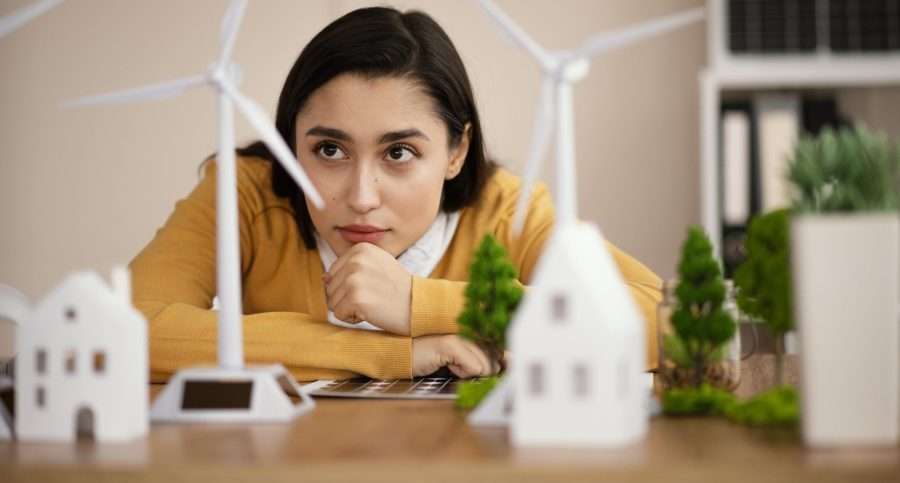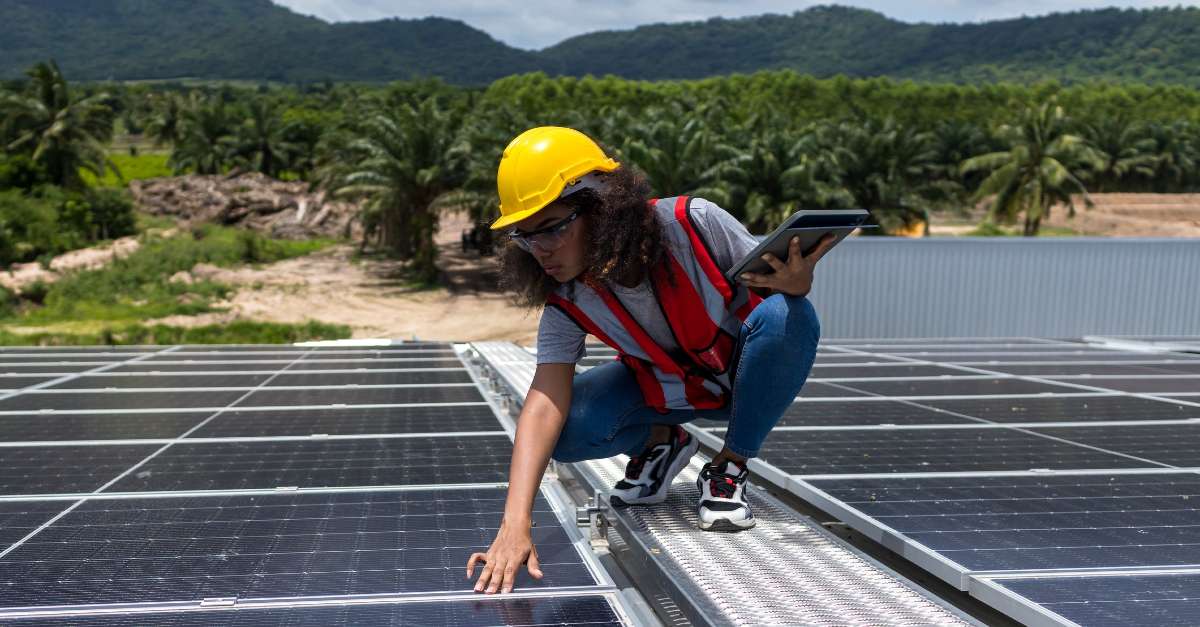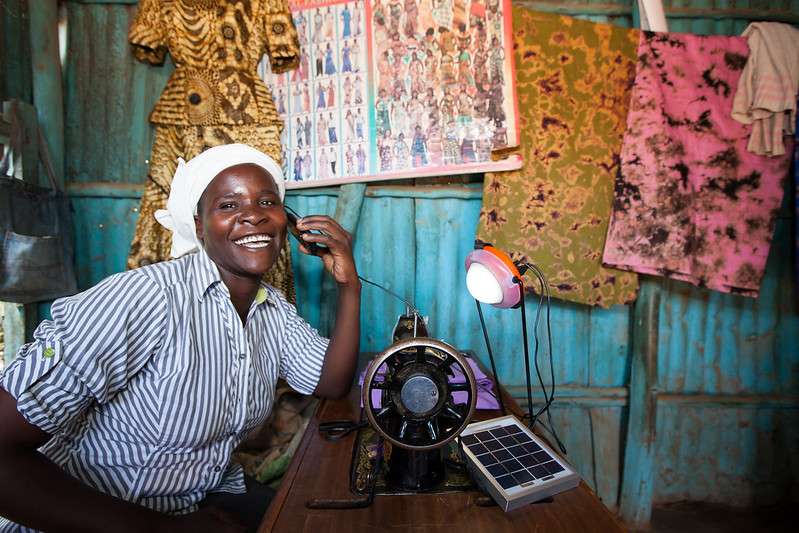“The innovation required of an emerging sustainable energy sector is so broad and immense, that it naturally invites and requires diversity in educational background and individual perspective”
– “Women for Sustainable Energy: Strategies to Foster Women’s Talent for Transformational Change” Report
Women in renewables can be agents of change. Renewable and decentralised energy solutions provide numerous options and huge promises for climate protection and social justice. All 17 Sustainable Development Goals (SDGs) are closely related to renewable energy, which, when used in a socially equitable manner, has the potential to significantly impact sustainable development. One of the most important problems to solve in the 21st century is gender disparity on a global scale. Gender inequality is a waste of human potential and a human rights concern, according to the SDGs’ fifth global target. In this context, the significance of renewable energy as a catalyst for gender equality (and female empowerment )is increasingly acknowledged. This is via advancing substantive and procedural rights, as women should be given more influence via renewable energy sources.
Women deserve gender equity- not simply in energy projects and programs, but also as crucial collaborators, development actors, experts, investors, producers, and energy consumers. This would enable diverse skill set utilisation for the social, ecological, and economic benefit of families, communities, and nations. Why do we need more women in renewables?

Source: Freepik
what is the renewable energy sector?
Renewable energy originates from naturally replenishing and endless sources, such as the sun and wind. Transportation, space and water heating and cooling, and electricity generation are all possible with renewable energy. Renewable resources have a nearly endless lifespan. The amount of energy they can produce per unit of time is constrained.
On the other hand, non-renewable fossil fuels like coal, oil, and gas require hundreds of millions of years to create. When fossil fuels are used to create energy, they emit dangerous greenhouse gases like carbon dioxide. In most nations, renewables are now more affordable and create three times as many jobs as fossil fuels, so having women in renewables is extensively important.
The respect shown to women and other underrepresented groups and minorities in the energy industry has declined. This is relevant to all clean energy and renewable energy technologies, including student chapters, and national & international chapters. It also affects networking get-togethers, field trips that build capacity, awards recognition programs, student bursaries, speed mentoring, speed interviewing, spotlights, conferences, workshops, and more.
Why Is a Gendered Perspective Relevant To the Energy Sector?
A gendered perspective recognises that some issues and constraints related to project success are gender specific. Men and women play different roles, have different needs, and face different constraints on a number of contrasting levels. Gender analysis is a methodology that aims to mitigate the different culturally and socially determined roles and responsibilities that men and women face in their communities, as well as inside the family unit. Numerous resources based on gender analysis back this up.
Why isn’t gender analysis used more frequently in the energy industry? Up until fairly recently, it wasn’t women alone who have been largely overlooked in energy planning and policy. People with many different socio-economic viewpoints, such as indigenous peoples, are included in this isolation.
Trends in Gender Analysis and Energy Policy
- Attention to the connections between energy, environment, and development
- Gender analysis viewing women as active participants
- More women in energy professions
- Increased international visibility of women’s organisations
- Gender training in the energy sector
- The rise of international and national networks on gender and energy
women in Renewables: providing Opportunities to Excel
Do we truly know how many of us have been successful in advancing past the beginnings of our professions to aspire higher? How many of us, despite recognition that we have received at work, leave due to private commitments, never coming back, only to speak about our jobs in the past tense?
Improving gender equality and awareness is a win-win situation rather than a zero-sum contest between the sexes. The lack of gender-disaggregated statistics on the subject makes it difficult to understand trends, obstacles, and opportunities for female employment in renewable energy. According to research, gender diversity in the workplace and income parity for men and women strengthen workplace relationships. The flow-on effect obviously benefits businesses, providing financial success.
In order to persuade renewable energy companies to hire, promote, and retain more women, it is essential and practical to gather gender-disaggregated statistics on employment in the field, and document and publicise the economic benefits of gender diversity.

Source: Freepik
Barriers to Leadership and Equity in the renewable energy sector
- Lack of access to land and capital
- Financial accessibility
- Resources and technology
- Gender-inclusive renewable energy policies and strategies at the national and regional levels
- Gender-based violence—due to cultural mindsets and stereotypes.
The poll results and the current literature point to many key areas of collective action needed. These include the demand to tailor training and skill-development programs, integrate gender equality into energy sector frameworks, work to attract and retain talent and challenge social and cultural norms. Despite significant differences between the modern energy and energy access contexts, these action areas highlight commonalities in both.
There is numerous social and economic potential associated with the current energy transition. The transition to a distributed, low-carbon energy system is being accompanied by a number of enabling policies, which are resulting in a wide range of benefits, including job possibilities.
According to the International Renewable Energy Agency, Decentralised Renewable Energy (DRE) solutions contributed to the creation of nearly 12.7 million employment in 2021. (IRENA and ILO, 2022). The numbers are anticipated to increase significantly over the ensuing decades, surpassing the number of employees lost to the use of fossil fuels.
Empowering women in renewables
Empowering women economically is a crucial component of overall development (World Bank, 2011). Even though men already participate in energy projects, women’s participation is not always equally represented. Investments in the energy sector can give women immediate economic benefits: by providing access to jobs in the formal economy, and by giving them the chance to start their own small businesses, develop their skills, and receive training. Through the provision of lighting and heat, for instance, such investments can also have indirect positive effects on the education, health, and nutrition of women and their families.
To create appropriate policies for improved livelihoods in the renewables sector, it is necessary to have a deeper understanding of the dynamics of energy use in production. Women who have been educated to design, install, maintain, and market solar systems, better cookstoves, or other renewable energy solutions sometimes still struggle to create long-term, reliable sources of income (ESMAP, 2013a).

Source: IRENA
Economic Opportunities for Women to access renewable energy
Access to Renewable Energy can encourage the development of alternative, climatically resilient livelihoods,
- Enhancing capacity to recover from disasters
- Increasing efficiency and output
- Promoting economic empowerment and encouraging more women to start their own businesses along the entire value chain
- Saving energy
- Promoting environmental protection, and
- Promoting overall community well-being and socioeconomic development
However, not every participant in a value chain for renewable energy is automatically provided with gains. For example, discriminatory gender norms may prevent women from travelling. As a result, they cannot work outside the house or community, attend training sessions, or participate in the marketing, installation, and maintenance of renewable energy sources.
Additionally, women are less likely to be given consideration for or be qualified for the kinds of jobs created by renewable energy projects. (ESMAP, 2013a). On the other hand, opportunities exist to improve and build women’s livelihoods along the value chains of renewable energy. Such initiatives can also support the implementation of strong social policies (Baruah, 2015).
Policy recommendations to promote better conditions for women in renewables
- Introduce dedicated “livelihood generation through Renewable Energy programme for women” to promote entrepreneurship.
2. Develop a national skill development programme (amongst the Renewable Energy sector) for women to ensure their access to sustainable technology
3. Introduce separate financing mechanism/scheme for enhancing female livelihood generation through renewable energy
4. Develop and implement a gender and Renewable Energy Action Plan
5. Ensure Renewable Energy integration in other relevant sectoral activities
6. Develop gender-specific indicators (wherever feasible) in the implementation of various Renewable Energy programs
why Is it essential that we focus on women in renewables?
The lack of gender-disaggregated statistics is a significant barrier to raising awareness of the issues and enhancing the gender balance in renewable energy. Therefore, it is crucial to make an effort to improve both quantitative and qualitative information. This holds true globally, across all geographies, and for both modern energy and energy availability contexts.
Government statistics will typically need to better reflect sector employment than they currently do and incorporate gender components into these efforts from the start. Women in renewables are absolutely essential. Building a gender-disaggregated evidence base can involve a variety of actions. These include academic and non-academic researchers, advocacy groups, professional associations, international organisations, non-governmental organisations (NGOs), policy institutes, and think tanks.
Women make up around a third of the workforce overall in the renewable energy business. Despite this, they appear to be more represented in the solar Photovoltaic System sector, where their proportion is 40% (IRENA, 2022). In decentralised renewable energy (DRE), where solar technologies are widely used, this is also true. An increasing amount of people are becoming aware of the circumstances in some nations. This includes Ethiopia, where women make up 37% of the DRE workforce (Power For All, 2022).

Source: Borgen Project
Supporting Female Entrepreneurs
As a UN organisation, Empower Women for Climate Resilient Societies aims to break the negative cycle in several areas.
Policy: Action plans to support female entrepreneurship and development, enhancing climate-resilient livelihoods. A generation of activities through renewable energy to ensure gender-inclusive national renewable energy policies and plans.
Capacity: Training and mentorship on business skills, financial literacy, operation, and maintenance of renewables-based enterprises. Incubation of enterprises, synergies with long-standing capacity-building programs and partnerships. Fostering regional knowledge and South-South learning.
Business model: Supporting women, enterprise projects, demonstration of a standard business model, detailed feasibility studies, and support for market linkages.
Finance: Support to access existing public and private funds and loans. Leveraging partnerships with government institutions to finance enterprises. Channeling co-funding based on standard requirements, targeting current and future women entrepreneurs.
Women’s economic empowerment and renewable energy in different sectors
- Renewable energy to improve productivity in existing value chains, (including powered water pumps to improve agriculture/ horticulture in drought-prone areas, and solar energy for crop drying, agro-processing, handicraft, and poultry).
- Renewable energy technology sale and supply (including the sale of solar lanterns, solar home systems, solar power packs, cookers, dryers, water heaters, biodigesters, and improved cookstoves for efficient cooking).
- Renewable energy for associated livelihood benefits (lighting systems, clean cookstoves, refrigeration and cooling, drinking water systems, and healthcare applications).

Source: Pixabay
Achieving the United Nations Sustainable Development Goals (SDGs)
A cross-country comparison of female representation in national parliaments showed that, globally, only 19 percent of parliamentary seats were occupied by women in 2015. Moreover, participation in the female labour force has not seen significant improvements since 2000, with the global average being two women for every three men. In 2016, women still represented just 40 percent of the global labour force and 23 percent of national decision-makers (SEforAll, 2018).
In ministries of energy, women are overrepresented in administrative positions, compared with men in managerial and technical areas. The main factors encouraging gender policies that promote women’s representation in the energy sector are national regulatory frameworks with clear objectives on gender. Corporate and social responsibility policies also factor in (World Bank ESMAP, 2018).
The energy sector doesn’t favour women in renewables and is specifically challenged by the lack of women in technical fields. This limits female participation in energy companies and their involvement as entrepreneurs. This leaves women outside of the retail segment of the value chain. Women also lack familiarity with new technologies when compared with men, particularly in rural settings (SEforALL, 2018).
moving forward
Finally, women are the mainstream consumers and frequently the providers of renewable energy, not a niche interest group. Renewable energy projects run the danger of being inappropriate and failing without their assistance. Women are the primary consumers of household energy in both developing and industrialised nations. They also influence or make many family purchases related to energy, are skilled business owners in the energy sector, and are active lobbyists for environmentally friendly energy sources through women’s organisations.
Manufacturers of renewable energy who ignore the demands of women will lose out on a substantial portion of the market. Energy authorities that overlook women’s needs will miss out on a major push for renewable energy development. Energy analysts and researchers that exclude women from their work will be missing a significant portion of energy production and use.
A Thrivable Framework
At THRIVE we believe that there is no sustainable business in an unsustainable world. Achieving only one SDG by 2030 is not enough. For those directly involved in implementation, as well as in monitoring impacts and benefits, gender analysis—the typical approach in all renewable energy projects—can provide right away useful insights. Nonetheless, the main conclusions necessary for action are clear, as stated in the report of the World Renewable Energy Congress.
A growing percentage of women and men, including activists, extensionists, researchers, policymakers, and donors, know that gender matters enough in renewable energy to merit special consideration. There is growing evidence that we need more women in renewables! The world is becoming increasingly aware that a gendered viewpoint only makes up a small part of the complex puzzle that can produce successful renewable energy projects and businesses. Not enough to guarantee success on its own, but an essential component of success.
To learn more about how The THRIVE Project is researching, educating, and advocating for a future beyond sustainability, please visit our website. You can follow our informative blog and podcast series and learn about our regular live webinars featuring expert guests in the field of sustainability, including many rich discussions on gender equality. Sign up for our newsletter for regular updates.























